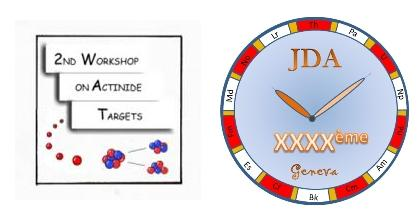Speaker
Dr
Piotr Gaczyński
(JRC Institut for Transuranium Elements)
Description
During the past decades ternary actinide-based compounds containing d- and p-electron elements have attracted much attention for their large variety of physical behaviors arising mostly from the hybridization of actinide 5f electrons with s, p and /or d states on neighboring sites. An example of a system with promising physical behavior is the ATX composition where A stands for actinide atoms, T for d-element metals and X for p-electron elements.
Among this family, the uranium stannite UPdSn exhibits an antiferromagnetic phase transition at 37 K leading to a magnetic structure with orthorhombic symmetry. A second transition occurs at 25 K and the magnetic structure becomes of monoclinic symmetry [1]. The plutonium analogue PuPdSn undergoes two successive antiferromagnetic transitions at 21 K and 9.6 K [2]. In contrast, the neptunium analogue NpPdSn exhibits only one antiferromagnetic transition at 19 K [3]. An effective magnetic moment μeff = 2.66 μB , close to the Np3+ free ion value, was inferred from magnetization measurements but the ordered moment was not determined in previous studies. Here, we present a 237Np Mössbauer investigation of the NpPdSn compound.
The ATX compounds crystallize in various crystal structures, like the hexagonal ZrNiAl- and GaGeLi- types, the orthorhombic TiNiSi- type and the cubic MgAgAs-type.
NpPdSn crystallizes into the hexagonal ZrNiAl-type structure with space group P-62m. A Rietveld analysis of the x-ray powder diffraction profile measured at room temperature has been performed to refine the lattice parameters and the internal atomic coordinates. The diffraction pattern is shown in Figure 1, together with the calculated profile and the residual line. The results show that the investigated sample is single-phase, with lattice parameters a = 7.5075Å and c = 4.0954 Å, in agreement with previous investigations [3]. The Np atoms occupy the 3f site (x=0.5875), the Pd atoms are located on the 1a and 2c sites and the Sn atoms fill the 3g site (x=0.2487).
237Np Mössbauer spectra were recorded between 4 K and 25 K in a transmission geometry spectrometer with a ~100mCi 241Am source kept at a temperature of about 4 K. The absorber was prepared by grinding the sample to a fine powder to ensure a constant surface density with an optimal thickness of 140mg Np/cm2. The velocity scale was calibrated using the NpAl2 standard compound. The isomer shift, IS, is given relative to NpAl2. The spectra were analyzed using Lorenzian lines. The position and relative intensities of the absorption lines of Np nuclei were calculated by solving the complete Hamiltonian for the hyperfine interaction in both the excited and ground nuclear state of 237Np.
Mössbauer spectra of NpPdSn at 25 K and 4.2 K are presented on the Figure 2.
Following the value of IS = 14.4 mm/s (vs NpAl2) we assigned a formal 3+ oxidation state to Np atoms [4], which is in agreement with the magnetization data.
In the paramagnetic region, the spectrum consists in only one a small quadrupolar splitting (QS), reflecting the fact that Np occupies a unique crystallographic site.
At 4K, the spectrum is split by the magnetic hyperfine interaction caused by the ordering of the magnetic moments. However, several subspectra - with equal IS and QS parameters but different magnetic hyperfine field Bhf - are required to reproduce the experimental pattern. In our fit, we used three different values of Bhf, corresponding to three different magnetic moments carried by the neptunium atoms. Two of the measured moments have a similar value (μNp = 1.53(5) μB and 1.44(5) μB), the third one is almost vanishing (μNp = 0.05(5)μB). The latter is indeed visible on the central line of the 4 K spectrum.
The higher number of subspectra than expected from the crystallographic structure may be due to different orientations of the principal axis (Vzz) of electric field gradient of Np atoms at 3f site vs. crystallographic axis, as observed in FeSn, crystallizing also into an hexagonal crystal structure [5]. The existence of several subspectra with different magnetic moments could also originate from a complex magnetic structure, like e.g. in NpIn3 where a modulated antiferromagnetic order, including vanishing moments, was observed by Mössbauer spectroscopy and neutron diffraction [6].
Acknowledgements
PG acknowledges the European Commission for support in the frame of the "Training and Mobility of Researchers" programme. The high purity Np metals required for the fabrication of the compound were made available through a loan agreement between Lawrence Livermore National Laboratory and ITU, in the frame of a collaboration involving LLNL, Los Alamos National Laboratory and the US Department of Energy.
References
[1] H. Nakotte, R.A. Robinson, A. Purwanto, Z. Tun, K Prokeš, E. Brück, F.R. de Boer, Phys Rev. B 58 9269 (1998)
[2] K. Gofryk, J.-Ch. Griveau, E. Colineau, R. Jardin, J. Rebizant, F. Wastin, R. Caciuffo, Journal of Nuclear Materials, 385, 220 (2009).
[3] K. Gofryk, J.-C. Griveau, R. Jardin, E. Colineau, J. Rebizant, F. Wastin, R. Caciuffo; Acta Phys Pol. A 115 7 (2009)
[4] G.M. Kalvius, J. Gal, L. Ash, W. Potzel; Hyp. Inter. 72 77 (1992)
[5] L. Häggström, T. Ericsson, R. Wäppling, K. Chandra, Phys Sripta. 11 47 (1975)
[6] E. Colineau, A. Blaise, P. Burlet, J. P. Sanchez and J. Larroque, Physica B: Cond. Matter 206-207, 528 (1995)
Primary author
Dr
Piotr Gaczyński
(JRC Institut for Transuranium Elements)
Co-authors
Dr
Eric Colineau
(JRC Institut for Transuranium Elements)
Franck Wastin
(JRC Institut for Transuranium Elements)
J. Rebizant
(JRC Institut for Transuranium Elements)
Jean-Christophe Griveau
(JRC Institut for Transuranium Elements)
Krzysztof Gofryk
(Los Alamos National Laboratory, Los Alamos)
R. Jardin
(JRC Institut for Transuranium Elements)
Roberto Caciuffo
(JRC Institut for Transuranium Elements)




